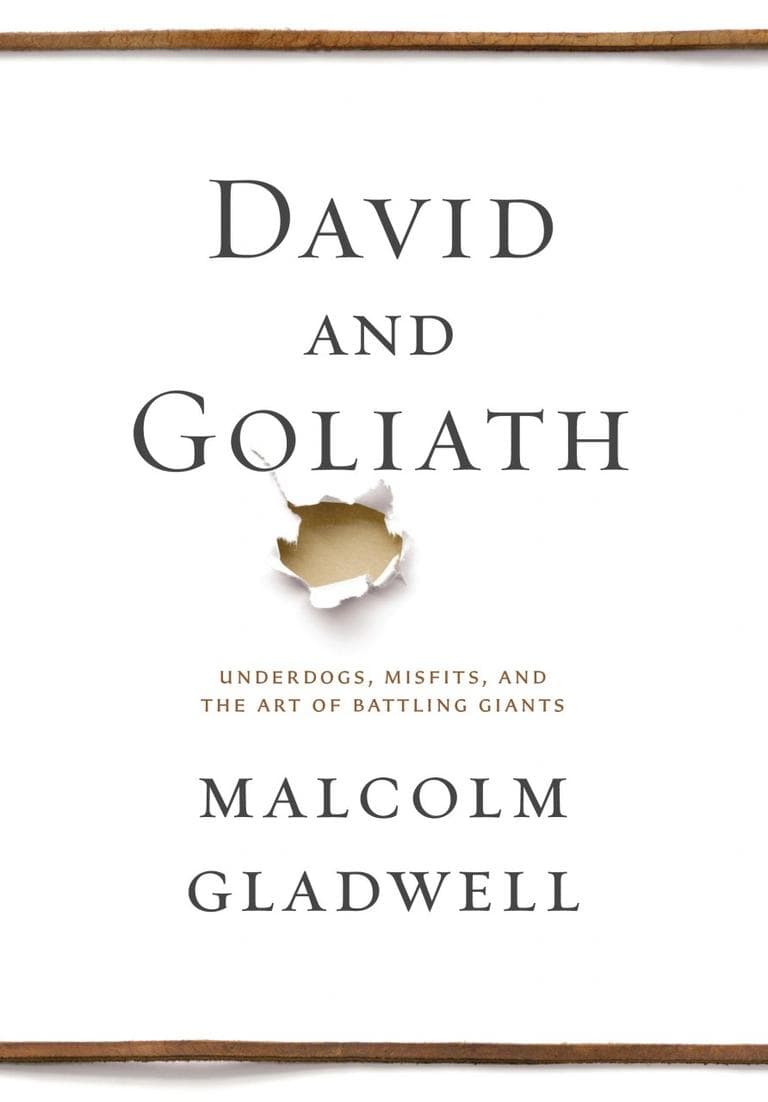Advertisement
Malcolm Gladwell's Take On 'David And Goliath'

You've heard the story of David and Goliath: the shepherd boy David takes up the challenge to fight the giant Goliath.
But David is at a huge disadvantage. He's much smaller, he doesn't have weapons or armor. How could he win?
In the end, David defeats Goliath in combat using a slingshot.
The underdog boy wins an improbable victory over the warrior giant.
Well, Malcom Gladwell thinks that we've got the meaning of that story all wrong.
In his new book, "David and Goliath: Underdogs, Misfits, and the Art of Battling Giants," Gladwell argues that our assumptions about power and advantage need to change.
"I was trying to ask the question about whether we have a good understanding of what an advantage is," Gladwell told Here & Now's Jeremy Hobson. "And the sort of argument of the book is that lots of things that look like advantages aren't, and lots of things that look like disadvantages may have more than silver linings, they may have all kinds of positively unintended consequences."
Book Excerpt: 'David and Goliath'
By Malcolm Gladwell
Introduction
Goliath
1.
“am i a dog that you should come to me with sticks?”
At the heart of ancient Palestine is the region known as the Shephelah, a series of ridges and valleys connecting the Ju¬daean Mountains to the east with the wide, flat expanse of the Mediterranean plain. It is an area of breathtaking beauty, home to vineyards and wheat fields and forests of sycamore and terebinth. It is also of great strategic importance.
Over the centuries, numerous battles have been fought for control of the region because the valleys rising from the Mediterranean plain offer those on the coast a clear path to the cities of Hebron, Bethlehem, and Jerusalem in the Judaean highlands. The most important valley is Aijalon, in the north. But the most storied is the Elah. The Elah was where Saladin faced off against the Knights of the Crusades in the twelfth century. It played a central role in the Maccabean wars with Syria more than a thousand years before that, and, most famously, during the days of the Old Testament, it was where the fledgling Kingdom of Israel squared off against the armies of the Philistines.
Advertisement
The Philistines were from Crete. They were a seafaring people who had moved to Palestine and settled along the coast. The Israelites were clustered in the mountains, under the leadership of King Saul. In the second half of the eleventh century bce, the Philistines began moving east, winding their way upstream along the floor of the Elah Valley. Their goal was to capture the mountain ridge near Bethlehem and split Saul’s kingdom in two. The Philistines were battle-tested and dangerous, and the sworn enemies of the Israelites. Alarmed, Saul gathered his men and hastened down from the mountains to confront them.
The Philistines set up camp along the southern ridge of the Elah. The Israelites pitched their tents on the other side, along the northern ridge, which left the two armies looking across the ravine at each other. Neither dared to move. To attack meant descending down the hill and then making a suicidal climb up the enemy’s ridge on the other side. Finally, the Philistines had enough. They sent their greatest warrior down into the valley to resolve the dead¬lock one on one.
He was a giant, six foot nine at least, wearing a bronze helmet and full body armor. He carried a javelin, a spear, and a sword. An attendant preceded him, carrying a large shield. The giant faced the Israelites and shouted out: “Choose you a man and let him come down to me! If he prevail in battle against me and strike me down, we shall be slaves to you. But if I prevail and strike him down, you will be slaves to us and serve us.”
In the Israelite camp, no one moved. Who could win against such a terrifying opponent? Then, a shepherd boy who had come down from Bethlehem to bring food to his brothers stepped forward and volunteered. Saul objected: “You cannot go against this Philistine to do battle with him, for you are a lad and he is a man of war from his youth.” But the shepherd was adamant. He had faced more ferocious opponents than this, he argued. “When the lion or the bear would come and carry off a sheep from the herd,” he told Saul, “I would go after him and strike him down and rescue it from his clutches.” Saul had no other options. He relented, and the shepherd boy ran down the hill toward the giant standing in the valley. “Come to me, that I may give your flesh to the birds of the heavens and the beasts of the field,” the giant cried out when he saw his opponent approach. Thus began one of history’s most fa¬mous battles. The giant’s name was Goliath. The shepherd boy’s name was David.
Guest
- Malcolm Gladwell, journalist and author of "David and Goliath: Underdogs, Misfits, and the Art of Battling Giants." He tweets @Gladwell.
This segment aired on October 15, 2013.